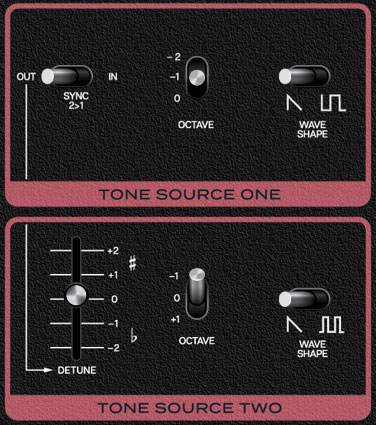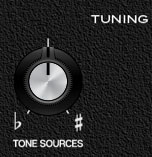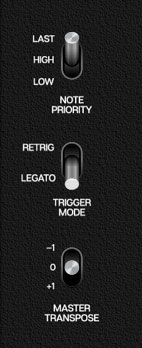
As monophonic analog synths go, MG-1 Plus is unique in that if features two standard mono analog oscillators (i.e., capable of sounding one note at a time), as well as a poly section that can sound up to 32 notes simultaneously. In this section, we'll discuss the mono oscillators. Note that the MG-1 front panel refers to oscillators as "tone sources;" perhaps Radio Shack felt this would be less intimidating for consumers than, "oscillator."
Sync 2>1- This causes Tone Source One to force reset the start of Tone Source Two's waveform to the beginning of its cycle, resulting in a wide range of harmonic tones from Tone Source Two. The range of tones can be varied by adjusting Tone Source Two's Detune and Octave controls.
Octave- Sets the pitch range for each oscillator in octaves.
Fine Tune (Tone Source Two only)- This can be used to fatten up two oscillator patches by detuning a small amount, or for "building-in" a set interval. Its range is a smidge over a fifth, up or down (unless the Sync 2>1 switch is on).
Wave Shape- These allow selection of sawtooth, square (Tone Source One), or pulse (Tone Source Two) waves.
Master Tuning and Note Priority/Trigger Controls

Tone Sources- The knob at the top left of the panel acts as a master tuning control for both Tone Sources, with a range of just over +/- 300 cents.

Note Priority- Since the Tone Generators are monophonic (i.e. they can only play one note at a time), this control determines which note will sound if more then one key is played simultaneously.
Last- This is the default voice mode. If more than one key is pressed, the most recently struck note will always take priority.
High- If more than key is pressed, the highest note will always sound.This how the original Realistic MG-1. Interestingly, this the opposite of how most vintage monophonic synths work - most are low-note priority.
Low- If more than key is pressed, the lowest note will always sound.
Trigger Mode- Determines Contour Generator triggering behavior. In Retrig position, the Contour Generator will retrigger any time a new note is played; in Legato position, retriggering only occurs if no other keys are currently held down - this is how most vintage monophonic analog synthesizers operate. Generally speaking Retrig mode will have a more modern and responsive feel, and is good for insistent bass lines or percussive sounds. Conversely, legato is useful for singing leads where you'd only want to hear the attack portion of a sound when the first note is played - a good analogy would be plucking a guitar string a single time, then sliding the fretting finger around to change pitches.
Master Transpose- Due to the limited range of the original instrument, we've added a three-position transpose switch at the left of the keyboard. This affects both Tone Sources, as well as the Poly section.